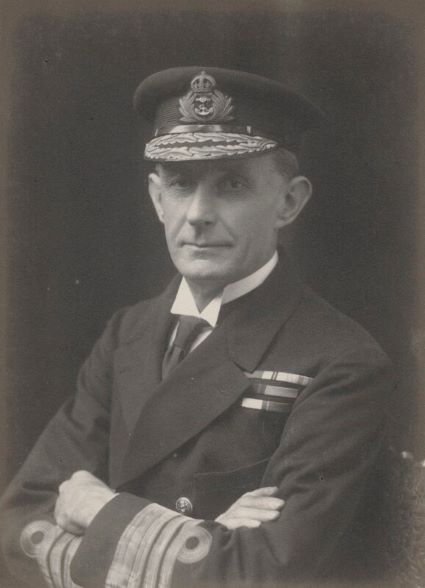
Reproduced with the kind permission of ©National Portrait Gallery x167928
Admiral Sir William Lowther Grant KCB (1864-1929) was born on 10th November 1864, the eldest boy in a family of six children. His father was a banker, and later a JP. They lived in the Portsmouth area, settling at Monckton House, Alverstoke in the 1870s.
Grant went to school at nearby Stubbington House, known as ‘the cradle of the Navy’, with close links to the training ship HMS Britannia, which he entered as a cadet in 1877. Although he had been placed twenty-third out of forty six successful candidates in the Naval Cadetship examination, he was described as ‘very promising’, and progressed from midshipman in 1879, to sub-lieutenant in 1883 after serving in the Anglo-Egyptian War (1882), and lieutenant in 1884.
In 1896 he qualified in torpedo duties and commanded a torpedo boat for manoeuvres in 1887. By 1893 Grant was recommended for promotion, as he was said to be ‘very trustworthy, and handles [the] flotilla with skill’. In 1896 he was commended again for his ‘zeal and ability’ in preparing a report on trials of a Howell Torpedo at Newport, Rhode Island, and in 1897 was promoted to Commander. From 1898 he worked at the Admiralty’s Naval Ordnance Department.
In January 1900 he landed in Cape Colony, was mentioned in despatches, and became a Captain in October 1900, in recognition of his service in the Second Boer War, where his detachment was nicknamed ‘Grant’s Guns’. He was in command of Monarch, Sutlej, Hawke and Cornwallis during the early 1900s, and was Naval Advisor to the Inspector-General of Fortifications. He acted as a Naval Aide-de-Camp to Edward VII in September 1908, and also became the Assistant to the Director of Naval Intelligence in the same year, before being promoted to the rank of Rear-Admiral in October 1909, shortly before his forty-fifth birthday.
From 1910 he was based at Sheerness (where he was stationed till November 1911), for special service with the Vice-Admiral Commanding the Third and Fourth Divisions of the Home Fleet. In King George V’s Coronation Honours in 1911, Grant was appointed Companion in the Military Division of the Most Honourable Order of the Bath, becoming a Knight Commander (K.C.B.) in 1917.
At the outbreak of the First World War, he initially commanded the Sixth Cruiser Squadron from HMS Drake, based at Scapa Flow, before he was promoted to Vice-Admiral in July 1915 and transferred abroad. He was then made Commander in Chief of the China Station in 1916, then Commander-in-Chief, North America and West Indies Station in 1918. By now Sir William Lowther Grant, he was promoted to the rank of Admiral on 1st September 1918. When he left the United States in 1919, the American Secretary of the Navy expressed his ‘sincere regret’ at the departure of ‘this talented and gifted officer’. For his wartime service abroad he was awarded the USA’s Distinguished Service Medal, the Légion d’Honneur, the Japanese Order of the Rising Sun, and also the Chinese Order of the Striped Tiger.
Grant retired in March 1920 ‘at his own request to facilitate the promotion of younger officers’, but at the United States’ request led a delegation in May 1922, at his own expense. In 1920 and 1924 he was reported in the press as defending Admiral Jellicoe’s decision to prioritise avoidance of the loss of ships at the Battle of Jutland in 1916.
William Lowther Grant married Mabel Emily Brodrick, the daughter of a clergyman, who conducted the ceremony, in 1892, and they had three children, Alan Lowther Grant born in 1897, Marjorie Harriet Grant born in 1898, and Richard Brodrick Grant, born circa 1901. During their married life the family moved around because of his naval career, but in the early 1920’s they settled in West Malling, at New Barns, where he died, after a short illness, on 30th January 1929, at the age of sixty four. His funeral was held in West Malling Church.
Ashford & Tenterden Canterbury, Herne Bay and Whitstable Dover, Deal & Sandwich Faversham, Isle of Sheppey and Sittingbourne Folkestone, Hythe & Romney Marsh Gravesend & Dartford Maidstone Margate, Broadstairs & Ramsgate Rochester, Chatham & Gillingham Sevenoaks Tonbridge and Malling Tunbridge Wells






